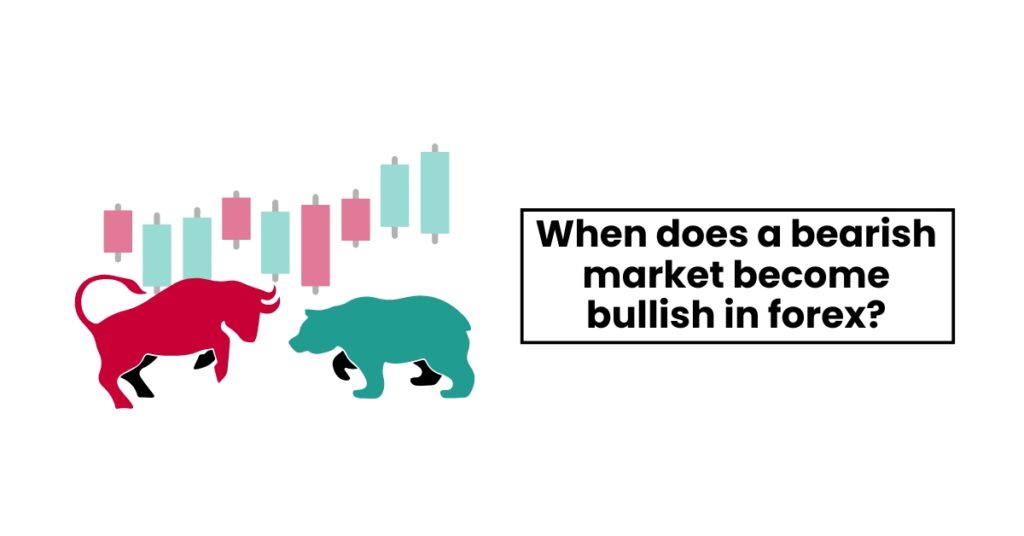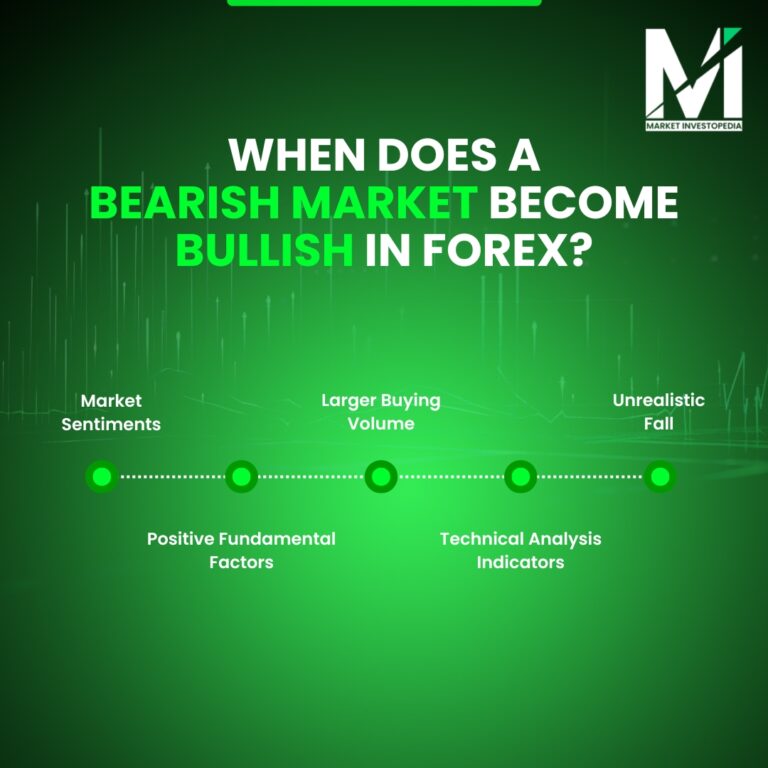When does a bearish market become bullish in forex?
Bull and Bear are the two most common terminologies in the market. Bull takes advantage of the price rise and bears trade the price falls. The trading world regularly observes a fight between bulls and bears.
And when one party takes control over the other, the market trend changes. In this Market Investopedia, we will analyze when a bearish market becomes bullish in forex.
It will help you trade efficiently in changing market conditions. But first, let’s discuss bullish and bearish markets for proper understanding.
What is a Bullish Market?
A bullish market is when the prices of financial assets are moving in an upward direction. All the technical analysis indicators, fundamentals, and investor sentiment favor the price rise. As a result, expecting the price to rise, traders enter a buy position.

A bullish market can be for a few minutes, days, weeks, or months. It totally depends on how strong the trend is. The main characteristics of a bullish market are when most investors feel like buying or expecting a price rise.
Example:
Suppose a trader is watching the EUR/USD chart, the technical analysis indicators, and the chart patterns shows a bullish move. Also, the US economic data comes out negative, which indicates that the USD value is expected to fall against the EUR, again suggesting a price rise for EUR/USD. So the market of EUR/USD is positive in this case, similar to a crypto bull market condition.
A quick glance
A bearish flag is a flag-like structure that appears on the chart and suggests a potential for a price drop.
A bull run can last for years. The financial market history has even witnessed bullish runs for 10 to 12 years.
Currently, we are in a period of consolidation, and the overall market outlook is mixed.
A market cycle can be of some minutes to even years.
In the context of markets, back in stock meaning might relate to asset availability or liquidity returning after a period of low volume.
To bear the risk means accepting potential losses or market volatility while expecting future gain.
Correction vs recession comparison helps understand if price declines are temporary (correction) or part of broader economic downturn (recession).
What is a Bearish Market?
A Bearish market is generally when most traders or investors feel that the asset price is set to fall. It is when the technical analysis indicators and fundamentals favor a price fall or pessimistic sentiments.
In the forex market, traders can even take advantage of price falls, predicting the bearish trend. Generally, a bearish trend occurs during economic imbalance, negative news, or a shift in sentiment. As a result, during such a scenario, traders prefer opening a sell position, especially when the stock market falling continues to drive fear.
Let us take the same example, suppose a trader is watching the EUR/USD chart, the technical analysis indicators, and the chart patterns shows a bearish move or oversold conditions. And, the US economic data comes out positive, which indicates that the USD value is expected to rise against the EUR. So, the market of EUR/USD is bearish in this case, possibly entering a bear market vs correction phase.
What bearish market become bullish mean?
A bearish market becomes bullish simply suggests a condition from a price fall to a price rise. Generally, when the asset prices were moving in a downward direction due to an event, the price started moving upward. That’s when the bearish market becomes bullish.
The price reversal is generally followed by a reason. For example, suppose the EUR/USD price were falling and a statement from a financial authority arrived. The statement favors the euro over the USD, which leads to a change in the price direction from bearish to bullish. This is common during a market bear rally, when investors start reassessing positions.
When does a bearish market become bullish in forex?
Identifying when a bearish market becomes bullish in forex is quite important. One wrong trend prediction and the entire market can change, ultimately impacting your profits. Thus, knowing when this trend change can happen helps you in making informed decisions. Here are the factors to watch:

Market Sentiments
What majority of people in the market feel can actually decide the price direction. If most people feel that prices are set to rise, then others also make a move in that direction, and vice versa. Thus, a change in market sentiment can change a trend from bearish to bullish. Risk off meaning can be observed when investors move away from risky assets, possibly ending a downtrend.
Positive Fundamental Factors
A bearish market can turn bullish due to positive fundamentals. It mainly includes positive news, favorable statements from influential people, positive economic outlook, employment data, and speeches. These ec impact factors often cause shifts in sentiment and price.
Larger Buying Volume
Volume basically deals with the number of trading activities. When the number of bull traders is more than the number of bear traders, it can change the trends. More buyers mean more belief in a particular currency, which leads to a trend reversal. It includes both assistant buyer positions and associate buyer positions, especially from institutional traders.
Technical Analysis Indicators
Technical analysis indicators also suggest a potential for trend reversal. A change from bearish to bullish can happen in the following case:
- When the Moving averages, Relative Strength Index, Bollinger bands, or other technical analysis indicators suggest oversold conditions.
- When the price touches the support levels, but can’t manage to break it. The conditions suggest that bulls somewhere are controlling bears and can even turn the price trend.
- When the technical analysis indicators and the price moves tell a different story. It leads to price divergence and even suggests a possibility for trend reversal.
- When a bullish or bullish reversal candlestick, such as bullish engulfing, morning star, or hammers, appears on the chart.
Such reversals are often accompanied by market shorts being squeezed or unwound as price moves upward. This is a signal to review buyer position and retail buyer position activities.
Unrealistic Fall
When the price of a currency pair falls unrealistically or falls to a level less than its worth, it suggests oversold conditions. And in this case, the market conditions suggest a potential for a change from a downward to an upward trend. This often happens when reserves market graph indicators signal imbalance.
Tips for Trading Bearish to Bullish Market Change
When your trades are open, keep an eye on overall market conditions, including sentiment and fundamental factors. It will help you identify trend changes earlier.
Don’t put all your capital in one asset. No one can predict a trend change with utmost accuracy. Thus, diversifying your capital leads to better risk management and account protection.
Always trade with proper stop loss and risk-to-reward ratio to save you from unexpected trend changes.
Use technical analysis indicators, tools, and concepts. This can guide you to change from a bearish to a bullish trend.
Have a right and balanced psychology. As an unexpected trend changes directly affects your mental state, ultimately impacting your trades. Don’t let bear loss or panic influence decision-making.
Wrapping Up
We have a detailed discussion on “when does a bearish market become bullish in forex”. Well, that’s quite a common scenario, bullish market turns bearish, and bearish turns bullish.
And if you organize proper research and use proper research tools then identifying such conditions is quite easy. But ignoring these conditions can turn your profitable trades into losing trades. So keep a watch on trend shift, especially in the dynamic market.
Also, if you want to learn some techniques to identify trend changes, attend our exclusive webinars. Here are forex market experts will share some valuable insights and techniques to deal with unexpected market changes. Join us and expand your forex market knowledge.
Understanding these shifts prepares you for whatever the market will bear, whether it’s a bear market vs recession scenario or the start of a bull run crypto surge.
